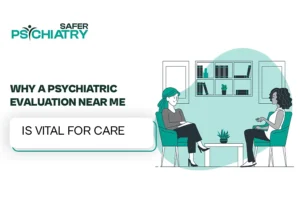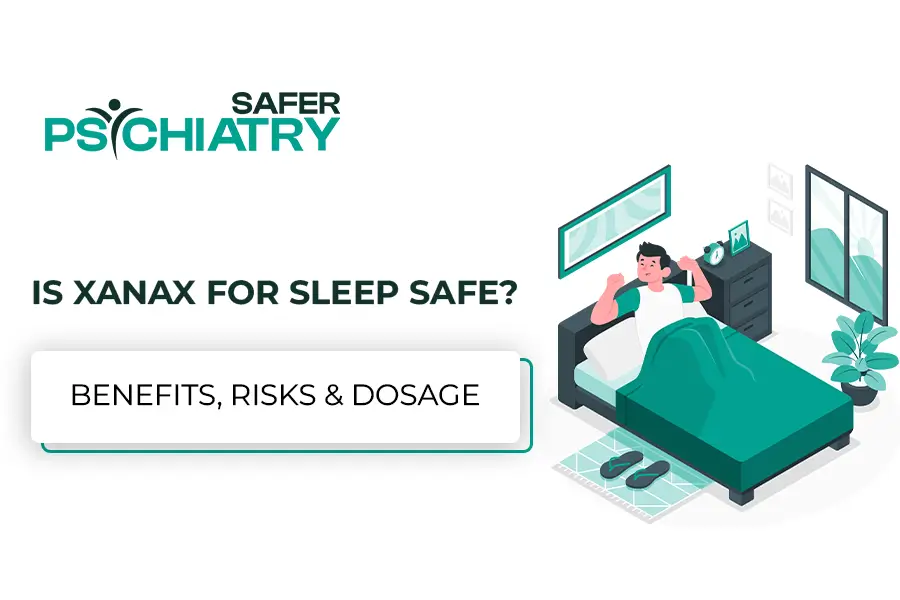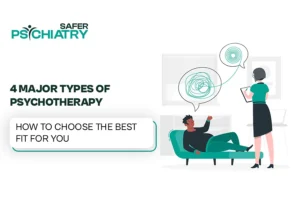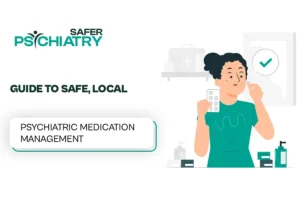
Is Xanax for Sleep Safe? Real Insights
You Need to Know
At Safer Psychiatry, we provide compassionate, evidence – based mental health care to support your well-being now and for the future – because your journey matters, and so do you.

Key Takeaways
- What It Is: Xanax (alprazolam) is a benzodiazepine prescribed mainly for anxiety and panic disorders—not FDA-approved as a sleep aid.
- How It Helps: Short-term relief by calming anxiety and promoting drowsiness, but not effective for long-term sleep improvement.
- Usual Dosage: Doctors may prescribe 0.25–0.5 mg at bedtime for insomnia linked to anxiety, only under close supervision.
- Risks: Dependence, tolerance, rebound insomnia, and disruption of REM sleep.
- Safer Alternatives: CBT-I, melatonin, Trazodone, hydroxyzine, gabapentin, and other non-habit-forming options.
What Is Xanax (Alprazolam)?
Xanax, the brand name for alprazolam, is a benzodiazepine most often used for anxiety and panic disorders. Due to its calming and sedating effects, it is sometimes prescribed off-label for sleep problems like anxiety-induced insomnia.
But is Xanax really a sleeping pill? The answer is no—it was never designed as a primary treatment for insomnia.
How Does Xanax Affect Sleep?
- Initial drowsiness: Xanax can help you fall asleep faster by reducing anxious thoughts.
- REM sleep disruption: It decreases deep, restorative sleep cycles, which are vital for memory and emotional health.
- Tolerance builds quickly: Within days, the usual dosage of Xanax for sleep (0.25–0.5 mg) may stop working effectively.
- Rebound insomnia: Stopping suddenly can cause worse insomnia than before.
So while Xanax may help in the short term, long-term use often backfires.
Common Side Effects of Xanax as a Sleep Aid
Using Xanax for sleep comes with risks:
- Daytime drowsiness and fatigue
- Dizziness and impaired coordination (risk of falls in elderly)
- Confusion and memory issues
- Emotional “numbness”
- In rare cases: paranoia, seizures, or suicidal thoughts
Important: Combining Xanax with alcohol, opioids, or other sedatives can be life-threatening.
Usual Xanax Dosage for Sleep
There is no official Xanax dosage for sleep, but doctors sometimes prescribe:
- 0.25 mg to 0.5 mg before bed – most common off-label use
- 0.5 mg alprazolam for sleep – prescribed in some cases, under strict supervision
- Higher doses (e.g., 5 mg) are unsafe and not recommended for sleep
Never adjust your dose without medical guidance.
Xanax for Sleep in Elderly Patients
Elderly patients are more sensitive to Xanax side effects, such as confusion, falls, and delirium. In this group, non-benzodiazepine options are much safer.
Alternatives to Xanax for Insomnia
If you’re considering Xanax as a sleeping pill, safer treatments may work better:
- CBT-I (Cognitive Behavioral Therapy for Insomnia): Gold standard, drug-free, sustainable.
- Melatonin: Natural, non-habit forming.
- Trazodone: Common off-label sleep aid.
- Hydroxyzine: Antihistamine sometimes used short-term.
- Gabapentin: Helpful in anxiety, pain, and sleep issues.
- Lifestyle approaches: Consistent bedtime, screen limits, relaxation techniques.
Patient Story – Real Experience
I started with just 0.25 mg of Xanax for sleep. It worked the first week, then I needed more. Soon I felt groggy every morning and panicked without it. With Safer Psychiatry’s help, I tapered off and switched to CBT-I and melatonin. Now, I sleep better, naturally.
Xanax vs. Other Sleep Aids
Option | Pros | Cons |
Xanax | Fast-acting, reduces anxiety | Risk of addiction, disrupts REM sleep |
Trazodone | Widely used for sleep | Morning grogginess possible |
Melatonin | Natural, non-habit forming | Mild effect |
Benadryl (diphenhydramine) | OTC, sedating | Poor long-term option |
CBT-I | Sustainable, safe | Requires time & effort |
Conclusion
Xanax may feel like a quick fix for sleepless nights, but it is not a sustainable solution. While it can reduce anxiety and help you fall asleep initially, long-term use often disrupts sleep quality, increases dependency risk, and creates new problems like rebound insomnia.
Safer Psychiatry, specialize in helping patients find personalized, safe, and effective treatments for insomnia and anxiety. Instead of relying on habit-forming medications, we guide you toward better options, whether it’s CBT-I, natural sleep aids, or tailored medication management.
Take the first step today- Schedule your Free Consultation with our expert psychiatrists and discover a safer path to restful, natural sleep.
Disclaimer: This content is for informational purposes only and is not medical advice. Always consult a licensed healthcare provider for diagnosis and treatment.
FAQ
Frequently Asked Questions
Is Xanax used for sleep or anxiety?
Xanax is primarily used for anxiety. While it can cause drowsiness, it’s not recommended as a long-term sleep aid.
What is the safest alternative to Xanax for sleep?
CBT-I, melatonin, or medications like trazodone or hydroxyzine may be safer and non-addictive alternatives.
Can Xanax and Trazodone be used both for sleep?
It’s possible but must be closely monitored by a doctor to avoid excessive sedation.
What’s the usual dosage of Xanax for sleep in the elderly?
Elderly patients are often prescribed lower doses (like 0.25mg), but benzodiazepines carry high risks in older adults.
Is Xanax good for sleep anxiety on planes?
It may help short-term anxiety during travel, but repeated use can lead to dependency.
Can You Take 2 Xanax for Sleep?
No, never take more than prescribed. Twin the dose increases the risk of overdose, obsession, and thoughtful side effects. Always speak to your psychiatrist before making any adjustments.
Our Company
Copyright © 2024 Safer Psychiatric Consulting Services


